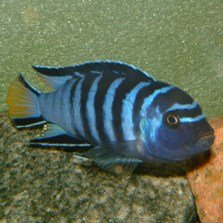Mbuna Cichlid
(Pseudotropheus Elongatus)
Slender Mbuna
Elongate Mbuna
 Mbuna Cichlid (Pseudotropheus Elongatus) |
Size: 5 Inches Temp Range: 75°F to 82°F pH Level: 7.5 to 9.0 Lifespan: 5 to 8 years Tank Size: 55 gallons Diet: Pellet, Flake, Vegetable, Algae Wafer Difficulty: Moderate |
Geographic History
This colorful fish comes from the northern regions of Africa's Lake Malawi near Tanzania. It can be found in rocky areas containing patches of sandy sediment.
Enviornment
The Mbuna Cichlid prefers a sandy or fine gravel substrate with lots of larger rocks scattered around. Some of the rocks should be stacked to form caves so that they will have dark areas to hide. Be sure to leave quite a bit of open area in the middle of the aquarium for swimming room. You should anchor plants well because they love to chew and tug on the leaves.
Compatibility
These brilliant fish are very aggressive, especially with males of their own kind and other similar colored species. They are not suited for a community aquarium after becoming adults. They do work well with Synodontis Catfish and larger Plecos though.
Sexing
Mbuna Cichlid males are bright blue with distinct black bands around their bodies. There will also be small spots on the males' bodies near their anal fins. The females are more brown in color with blue heads. The black banding is very faint on females.
Behavior
This African Cichlid is very aggressive and will require a good amount of space in your aquarium. The males will claim a rock as their micro-habitat territory and will engage any fish that challenges his area.
It is usually not a good idea to have more than one male present in your aquarium, unless it is very large. These fish are best kept as one male and two or three females. This reduces male aggressiveness and spawning stress on the females.
Breeding
The Mbuna Cichlid becomes sexually mature when they are about three inches long. The males will initiate spawning by dancing around in front of the female. If she is ready to spawn, she will follow him to a bed that he has previously dug in the substrate.
Once the breeding pair have reached the spawning bed, the female will lay 10-20 eggs in it. She then promptly scoops the eggs into her mouth. While she is doing this, the male will rub the spotted area near his anal fin in front of her mouth. These spots trick the female into thinking they are eggs. When she goes to gather the spots in her mouth, the male fertilizes the eggs she has already scooped up. This behavior will be repeated several times during the spawning.
The eggs hatch in a few days, and the female protects the fry by keeping them in her mouth for about a month. The fry will leave her mouth to feed on baby brine shrimp and crushed flake. The female will stay close to the fry and allow them to swim into her mouth again if they feel threatened. Males have no part in the protection of the fry after spawning.
After the eggs have hatched, take care to not remove the female from the aquarium where her fry were spawned. She may become stressed and eat them.
For more information, go to Wikipedia's Mbuna Cichlid page.





